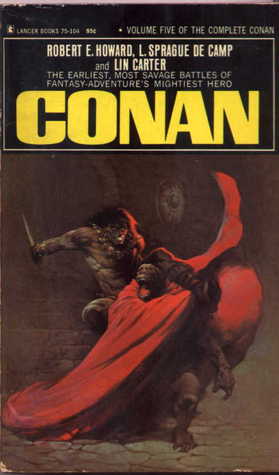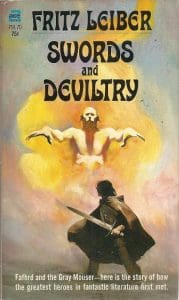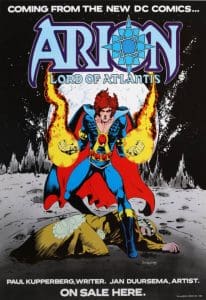 The first sword and sorcery I ever read was Robert E. Howard’s Conan, in the books published in the mid-1960s in paperback by Lancer Books, with the soon to become iconic cover paintings by Frank Frazetta. My father had brought home a recently published paperback edition of Tarzan of the Apes by Edgar Rice Burroughs that someone had left behind at his office. I recognized the Ape Man from the movies I’d seen on TV, but I wasn’t prepared for what I read. It was like I had discovered the real-life version of what was, essentially, portrayed as a grunting cartoon character in the movies. It floored me. I still think it’s a great novel, as close to literature as pulp fiction got when it was published in 1912. I reread it every few years.
The first sword and sorcery I ever read was Robert E. Howard’s Conan, in the books published in the mid-1960s in paperback by Lancer Books, with the soon to become iconic cover paintings by Frank Frazetta. My father had brought home a recently published paperback edition of Tarzan of the Apes by Edgar Rice Burroughs that someone had left behind at his office. I recognized the Ape Man from the movies I’d seen on TV, but I wasn’t prepared for what I read. It was like I had discovered the real-life version of what was, essentially, portrayed as a grunting cartoon character in the movies. It floored me. I still think it’s a great novel, as close to literature as pulp fiction got when it was published in 1912. I reread it every few years.
My next trip to the library after that included a hunt for more ERB. I was rewarded with John Carter of Mars (so…score!), which was my gateway to sword & sorcery. As I recall, it was on a later library visit that I spotted Conan on the paperback rack, where the librarian told me I might find some more ERB books. Conan was hard to miss: a dark scene of a ripped barbarian in a life and death struggle with a gorilla wearing a startling crimson cloak!
Like toppling dominos, that library paperback spinner rack Conan (the best things in my childhood were sold on spinner racks!) lead to Michael Moorcock’s Elric and Eternal Warrior and Lin Carter’s Thongor and to L. Sprague DeCamp and Andrew J. Offutt and the rest of the 1960s explosion of S&S authors, including Fritz’s Lieber’s Fafnir and the Gray Mouser.
 Fafnir and the Gray Mouser stood out from the barbaric crowd. First, they weren’t exactly barbarians. I mean, technically sure, the giant swordsman and minstrel Fafnir and his partner, the diminutive former wizard’s apprentice and swordsman hailed from barbaric roots, but they were more sophisticated and cosmopolitan than their loin-cloth wearing brethren. Fafnir and the Mouser were rogues and more true-to-life, characters who acted in the world instead of just reacting. Not only were Lieber’s stories witty, his characters had senses of humor. No grim and gritty angst-filled monologues for these cheating, brawling, larcenous, wenching adventurers. Their swords were for hire and life was good.
Fafnir and the Gray Mouser stood out from the barbaric crowd. First, they weren’t exactly barbarians. I mean, technically sure, the giant swordsman and minstrel Fafnir and his partner, the diminutive former wizard’s apprentice and swordsman hailed from barbaric roots, but they were more sophisticated and cosmopolitan than their loin-cloth wearing brethren. Fafnir and the Mouser were rogues and more true-to-life, characters who acted in the world instead of just reacting. Not only were Lieber’s stories witty, his characters had senses of humor. No grim and gritty angst-filled monologues for these cheating, brawling, larcenous, wenching adventurers. Their swords were for hire and life was good.
Unfortunately, when I finally got to create my own sword and sorcery character for DC Comics in 1982, I seemed to have forgotten the wit. The very first installment of Arion, Lord of Atlantis (appearing as a back-up in Mike Grell’s Warlord #55 (March, 1982) opens with steely-eyed warriors ominously eyeing the coming storm and angsty young Arion spouting his ominous feelings in pseudo-Shakespearean tones. The series (which was co-created with artist Jan Duursema and ran for eight issues in the back of Warlord, and thirty-five issues plus a one-shot in its own title) wasn’t entirely without humor; I always had a knack for witty dialog, but the tone of the series was dry and serious.
 I fixed that but good in 1992 when I revived the character in 1992’s Arion the Immortal miniseries (with art by Ron Wilson). It’s 45,000 years later, Atlantis has long sunk beneath the sea (taking all but the most minute bits of powerful magic with it), and there’s a colony of surviving Atlantean deities living in modern-day New York City. Arion is one of them, the quintessential “you kids get off my lawn or I’ll turn the hose on you!” old man, wrinkled and frail looking. He lives in a one-room apartment over Carnegie Hall and makes his living as a three-card monte dealer in Times Square. His ancient foe owns a deli on the Lower East Side that he eats in all the time. And when the magic returns, making Arion young again, well, chaotic hilarity ensued.
I fixed that but good in 1992 when I revived the character in 1992’s Arion the Immortal miniseries (with art by Ron Wilson). It’s 45,000 years later, Atlantis has long sunk beneath the sea (taking all but the most minute bits of powerful magic with it), and there’s a colony of surviving Atlantean deities living in modern-day New York City. Arion is one of them, the quintessential “you kids get off my lawn or I’ll turn the hose on you!” old man, wrinkled and frail looking. He lives in a one-room apartment over Carnegie Hall and makes his living as a three-card monte dealer in Times Square. His ancient foe owns a deli on the Lower East Side that he eats in all the time. And when the magic returns, making Arion young again, well, chaotic hilarity ensued.
These days, it’s hard to keep humor out of my writing, the more cynical or darker the better. That’s why when I was presented with the world of the Crimson Keep in which to write a short story shortly after being inducted into the ranks (you don’t know how rank sometimes!) of Crazy 8 Press, I had no problem coming up with “The Wee Folk at the End of the Hall” for the 2015 Tales of the Crimson Keep anthology. The world and characters in which this was set had been created by Peter David, Michael Jan Friedman, Robert Greenberger, Glenn Hauman, and Aaron Rosenberg in “Demon Circle,” a round-robin story written live at a convention in support of the Comic Book Legend Defense Fund.
The Crimson Keep is home to an old wizard and his apprentices, but it’s not exactly a steady home. The rooms and corridors and stairways in the Keep are constantly shifting and changing. Stray from well-used routes between familiar rooms and you can be lost for days or weeks or forever in the infinitely-possible layout. And, seeing as how my Crazy 8 comprades are no slouches at the funny themselves (except for Hauman, but we take care of him in They Keep Killing Glenn…now on sale!), there’s ample opportunities for wit built right into the concept.
Which brings us to Tales of the Crimson Keep: The Newly Renovated Edition, featuring not one but two (count ‘em, two!) new stories. The first is “Glisk of the Keep” by the newest addition to the C8 crew, Mary Fan. The second is “Poor Wandering Ones,” a poignant round-robin tale by all eight of the Crazy 8. All that…plus an eye-popping new cover by the amazing Ty Templeton.
I’ve feel like I’ve come a long way since Conan!
Tales of the Crimson Keep: The Newly Renovated Edition will go on sale later this month.

